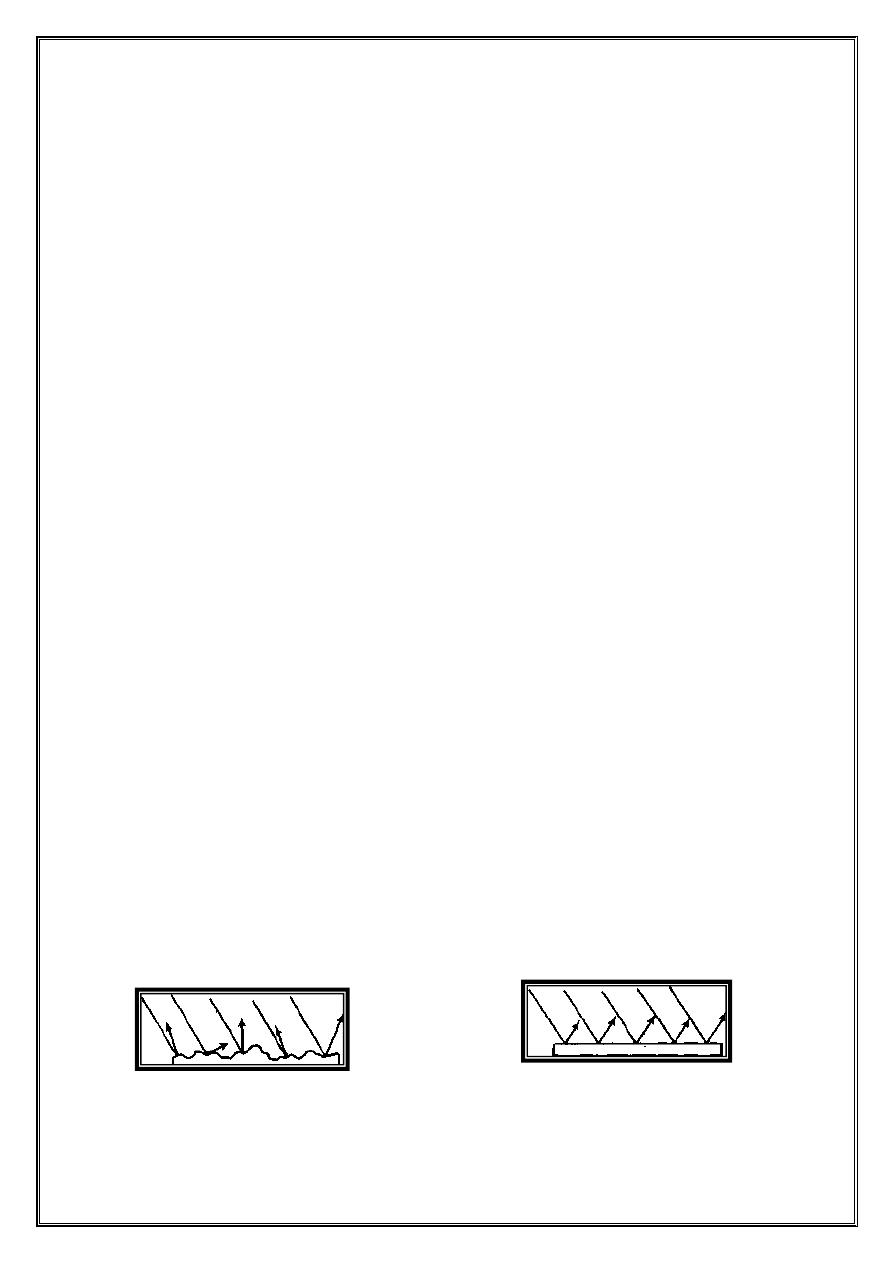
- 1 -
College of Medicine
Time : 2 hrs
Dept. of Physio& Medical Physics Jun:8 ,2020
Light in Medicine Course : MPH2
****************************************************************************
Light in Medicine
/PART1
Introduction
Even though man is now very efficient at making artificial light, the sun is
still the major source of light in the world . The sun is both beneficial and
hazardous to our health . The light visible to the human eye and the eye is
most efficient in the wavelengths corresponding to the maximum output from
the sun .
Light has some interesting properties, many of which are used in
medicine :
1. The speed of light changes when it goes from material into another . The ratio
of the speed of light in a vacuum to its speed in a given material is called the
index of refraction . If a light beam meets a new material at an angle other
than perpendicular, it bends, or is refracted . This property permits light to be
focused and is the reason we can read and see objects clearly.
2. Light behaves both as a
wave and as a particle. As a wave it produces
interference and diffraction, which are of minor importance in
medicine . As a particle it can be absorbed by a single molecule. When a light
photon is absorbed its energy is used in various ways. It can cause a chemical
change in the molecule that in turn can cause an electrical change. This is
basically what happens when a light photon is absorbed in one of the sensitive
cells of the
retina ( the light – sensitive part of the eye). The chemical change
in a particular point of the retina triggers an electrical signal to the brain to inform

- 2 -
it that a light photon has been absorbed at that point .
3. When light is
absorbed, its energy generally appears as heat. This property
is the basis for the use in medicine of lR light to heat tissues. Also, the heat
produced by laser beams is used to "
weld" a detached retina to the back of the
eyeball and to coagulate small blood vessels in the retina.
4. Sometimes when photon is absorbed, a lower energy light photon is
emitted. This property is known as
fluorescence, it is the basis of the
fluorescent lightbulb. Certain materials fluoresce in the presence of UV light,
sometimes called "
black light," and give off visible light. The amount of
fluorescence and the color of the emitted light
depend on the wavelength of the
UV light and on the chemical composition of the material that is fluorescing.
One way fluorescence is used in medicine is in the detection of
porphyria,
a condition in which the teeth fluoresce red when irradiated with UV light.
Another important application is in fluorescent microscopes.
5. Light is
reflected to some extent from all surfaces. There are two types of
reflection.
Diffuse reflection occurs when rough surfaces scatter the light in
many directions.
Specular reflection is a more useful types of reflection; it is
obtained from very smooth shiny surfaces such as mirrors where the light is
reflected at an angle that is equal to the angle at which it strikes the surface.
Mirrors are used in many medical instruments. One simple instrument is a
mirror that is a mirror that is held at the back of a patient's throat to look
at his vocal folds.
Diffuse reflection Specular reflection

- 3 -
Measurement of light and its units
The three general categories of light - UV, visible, and IR. Wavelengths
of light used to be measured in microns (1 μ = 10
-6
m) or in angstroms (1 Å
= 10
-10
m), but at present the recommended unit is the nanometer (1 nm =
10
-9
m). Ultraviolet light has wavelengths from about 100 to 400 nm;
visible light extends from about 400 to 700 nm; and IR light extents from
about 700 to over 10
4
nm.
Applications of visible light in medicine
An obvious use of visible light in medicine is to permit the physician
to obtain visual information about the patient regarding,
for example,
the color of his skin and the presence of abnormal structures in or on his
body. It is quite easy for a physician to examine the skin under normal
lighting conditions, but when she wishes to look into a body opening she is faced
with the practical problem of getting light into the opening without obstructing
the view. Like a lot of tricks, this one is done with mirrors. The curved
surface focuses the light at the region of interest. More sophisticated
instruments, such as the
ophthalmoscope for looking into the eyes and the
otoscope for looking into the ears, use basically the same principle.
A number of instruments, called
endoscopes, are used for viewing
internal body cavities. Special purpose endoscopes are often given names
indicating their purpose.
For example, cystoscopes are used to examine
the bladder,
proctoscopes are used for examining the rectum, and
bronchoscopes are used for examining the air passages into the lungs.
Some endoscopes are rigid tubes with a light source to illuminate the area of
interest. Many of them are equipped with optical attachments to magnify the
tissues being studied.

- 4 -
The development of
fiberoptic techniques permitted the construction of
flexible endoscopes.
Flexible endoscopes can be used to obtain information
from regions of the body that cannot be examined with
rigid endoscopes,
such as the small intestine and much of the large intestine. Some flexible
endoscopes are over a meter in length. The image obtained with a flexible
endoscope is not as good as that obtained with a rigid endoscope, but often
the only alternative to a flexible endoscopic examination is exploratory
surgery. Flexible endoscopes usually have an opening or channel that
permits the physician to take samples of the tissues (
biopsies) for later
microscopic examination.
Since light contains energy that largely appears as heat when it is
absorbed, there is a limit on the amount of light that can be used in
endoscopy. For endoscopy, the heating can be reduced by reducing the IR
light from the source with special IR absorbing glass filters. In this
cold -
light endoscopy the light source contains very little IR radiation and the
heating of tissues is minimized.
Transillumination is the transmission of light through the tissues of
the body. Most of us have at one time or another shone a flashlight through
our fingers to see the red glow that is produced . The glow is primarily red
because most of the other colors in the beam are absorbed by the red blood
cells; the red light is the only important component that is transmitted .
Transillumination is used clinically in the detection of
hydrocephalus (
water-head) in infants. Since the skull of young infants
is not fully calcified, light is able to penetrate to the inside of the skull; if
there is an excess of relatively clear cerebrospinal fluid (CSF) in the skull,
light is scattered to different parts of the skull producing patterns
characteristic of hydrocephalus . The special transilluminating device uses

- 5 -
a 150 W projection bulb as the light source with a two position trigger switch
The infant is taken into a dark room for the study; after a few minutes of
dark adaptation the physician pulls the trigger to its first position, which
turns on a red light that permits him to find the patient. The physician then
points the barrel at the part of the head to be studied and pulls the trigger to
the second position, which turns off the red light and turns on the intense
white light used for the study. Infrared absorbing glass in the beam removes
almost all of the IR radiation so that the light striking the infant is primarily
visible light.
Transillumination is also used to detect pneumothorax (collapsed
lung) in infants . The bright light penetrates the thin front chest wall and
reflects off the back chest wall to indicate the degree of pneumothorax.
The physician can then insert a needle attached to a syringe into the area of
collapse to remove the air between the lung and chest wall, causing the
lung to reinflate. The sinuses, the gums, the breasts, and the testes have
also been studied with transillumination.
Visible light has an important
therapeutic use. Since light is a form
of energy and is selectively absorbed in certain molecules, it should not be
surprising that it can cause important physiological effects. Many premature
infants have
jaundice, a condition in which an excess of bilirubin is
excreted by the liver into the blood. It was discovered that most
premature infants recover from jaundice if their bodies are exposed to
visible light (
phototherapy) and the blue light (~ 450nm) appears to be
the most important component.
